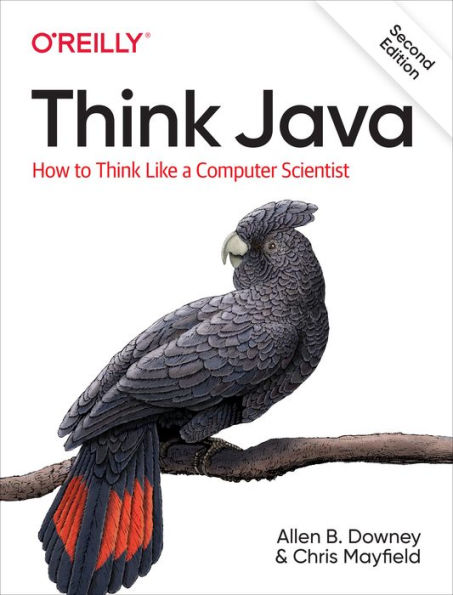

Paperback(2nd ed.)
-
PICK UP IN STORECheck Availability at Nearby Stores
Available within 2 business hours
Related collections and offers
Overview
In this fully updated and expanded edition, authors Allen Downey and Chris Mayfield introduce programming as a means for solving interesting problems. Each chapter presents material for one week of a college course and includes exercises to help you practice what you’ve learned. Along the way, you’ll see nearly every topic required for the AP Computer Science A exam and Java SE Programmer I certification.
- Discover one concept at a time: tackle complex topics in a series of small steps with multiple examples
- Understand how to formulate problems, think creatively about solutions, and develop, test, and debug programs
- Learn about input and output, decisions and loops, classes and methods, strings and arrays, recursion and polymorphism
- Determine which program development methods work best for you, and practice the important skill of debugging

Product Details
| ISBN-13: | 9781492072508 |
|---|---|
| Publisher: | O'Reilly Media, Incorporated |
| Publication date: | 12/17/2019 |
| Edition description: | 2nd ed. |
| Pages: | 323 |
| Sales rank: | 1,122,373 |
| Product dimensions: | 6.90(w) x 9.10(h) x 0.80(d) |
About the Author
Chris Mayfield is an Assistant Professor of Computer Science at James Madison University, with a research focus on CS education and professional development. He has a Ph.D. in Computer Science from Purdue Universityand Bachelor's degrees in CS and German from the University of Utah.
Table of Contents
Preface ix
1 Computer Programming 1
What Is a Computer? 1
What Is Programming? 2
The Hello World Program 3
Compiling Java Programs 4
Displaying Two Messages 6
Formatting Source Code 6
Using Escape Sequences 7
What Is Computer Science? 8
Debugging Programs 9
Vocabulary 10
Exercises 12
2 Variables and Operators 15
Declaring Variables 15
Assigning Variables 16
Memory Diagrams 17
Printing Variables 18
Arithmetic Operators 19
Floating-Point Numbers 20
Rounding Errors 21
Operators for Strings 22
Compiler Error Messages 23
Other Types of Errors 24
Vocabulary 25
Exercises 27
3 Input and Output 29
The System Class 29
The Scanner Class 30
Language Elements 31
Literals and Constants 32
Formatting Output 34
Reading Error Messages 35
Type Cast Operators 36
Remainder Operator 37
Putting It All Together 38
The Scanner Bug 39
Vocabulary 40
Exercises 41
4 Methods and Testing 45
Defining New Methods 45
Flow of Execution 46
Parameters and Arguments 47
Multiple Parameters 49
Stack Diagrams 50
Math Methods 51
Composition 52
Return Values 53
Incremental Development 54
Vocabulary 56
Exercises 57
5 Conditionals and Logic 63
Relational Operators 63
The if-else Statement 64
Chaining and Nesting 65
The switch Statement 66
Logical Operators 67
De Morgan's Laws 69
Boolean Variables 69
Boolean Methods 70
Validating Input 71
Example Program 72
Vocabulary 73
Exercises 74
6 Loops and Strings 79
The while Statement 79
Increment and Decrement 81
The for Statement 81
Nested Loops 83
Characters 84
Which Loop to Use 85
String Iteration 86
The indexOf Method 87
Substrings 87
String Comparison 88
String Formatting 89
Vocabulary 90
Exercises 91
7 Arrays and References 95
Creating Arrays 96
Accessing Elements 97
Displaying Arrays 98
Copying Arrays 99
Traversing Arrays 100
Generating Random Numbers 102
Building a Histogram 103
The Enhanced for Loop 104
Counting Characters 105
Vocabulary 107
Exercises 108
8 Recursive Methods 111
Recursive Void Methods 111
Recursive Stack Diagrams 113
Value-Returning Methods 114
The Leap of Faith 116
Counting Up Recursively 117
Binary Number System 118
Recursive Binary Method 119
CodingBat Problems 120
Vocabulary 122
Exercises 123
9 Immutable Objects 129
Primitives Versus Objects 129
The null Keyword 130
Strings Are Immutable 131
Wrapper Classes 132
Command-Line Arguments 134
Argument Validation 135
BigInteger Arithmetic 135
Incremental Design 137
More Generalization 139
Vocabulary 140
Exercises 141
10 Mutable Objects 147
Point Objects 147
Objects as Parameters 148
Objects as Return Values 149
Rectangles Are Mutable 150
Aliasing Revisited 151
Java Library Source 152
Class Diagrams 153
Scope Revisited 154
Garbage Collection 154
Mutable Versus Immutable 155
StringBuilder Objects 155
Vocabulary 157
Exercises 158
11 Designing Classes 161
The Time Class 161
Constructors 162
Value Constructors 164
Getters and Setters 165
Displaying Objects 167
The toString Method 167
The equals Method 168
Adding Times 170
Vocabulary 172
Exercises 173
12 Arrays of Objects 175
Card Objects 175
Card toString 177
Class Variables 178
The compareTo Method 179
Cards Are Immutable 180
Arrays of Cards 181
Sequential Search 183
Binary Search 183
Tracing the Code 184
Vocabulary 185
Exercises 186
13 Objects of Arrays 189
Decks of Cards 189
Shuffling Decks 190
Selection Sort 192
Merge Sort 192
Subdecks 193
Merging Decks 194
Adding Recursion 195
Static Context 196
Piles of Cards 197
Playing War 199
Vocabulary 200
Exercises 201
14 Extending Classes 205
CardCollection 206
Inheritance 208
Dealing Cards 209
The Player Class 211
The Eights Class 212
Class Relationships 215
Vocabulary 216
Exercises 216
15 Arrays of Arrays 219
Conway's Game of Life 219
The Cell Class 221
Two-Dimensional Arrays 222
The GridCanvas Class 223
Other Grid Methods 224
Starting the Game 225
The Simulation Loop 226
Exception Handling 227
Counting Neighbors 227
Updating the Grid 229
Vocabulary 231
Exercises 231
16 Reusing Classes 235
Langton's Ant 235
Refactoring 237
Abstract Classes 238
UML Diagram 240
Vocabulary 241
Exercises 241
17 Advanced Topics 243
Polygon Objects 243
Adding Color 244
Regular Polygons 245
More Constructors 247
An Initial Drawing 248
Blinking Polygons 250
Interfaces 251
Event Listeners 253
Timers 256
Vocabulary 257
Exercises 258
A Tools 259
B Javadoc 271
C Graphics 279
D Debugging 287
Index 299
